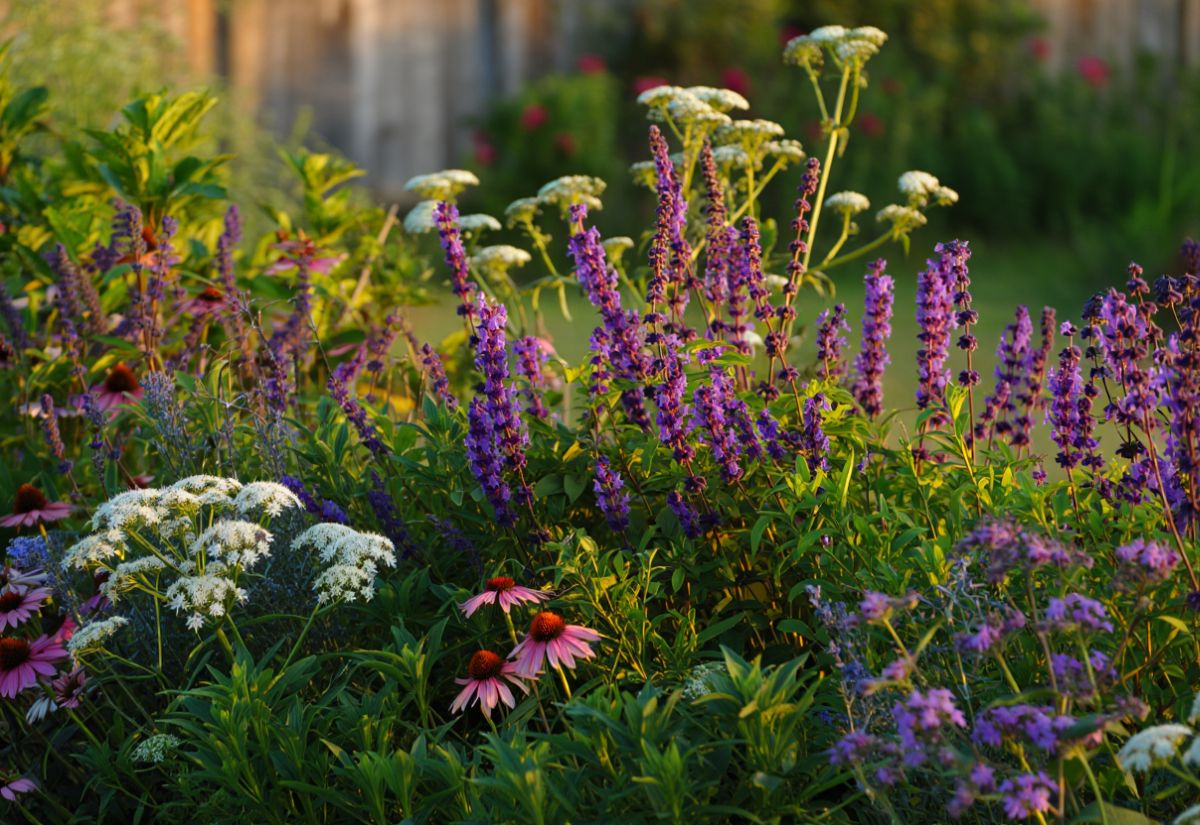
Now the south of England is filling with lavender fields like France, but maybe you don’t want to have this amazingly fragrant shrub on its own in your garden? And you’d be right! Finding a good companion for Lavandula means growing a “little green and flowering family” – and it has many advantages… The aesthetics of your garden, to start with, but also soil protection, attracting pollinators and repelling pests and unwanted guests to your land.
So, if you are thinking about finding a friend, a companion (or more) for your lavender shrub, choose wisely from this list of ideal partners, because some plants are not suitable at all.
Let’s start with some basic points…
What Qualities Should Companion Plants for Lavender Have?
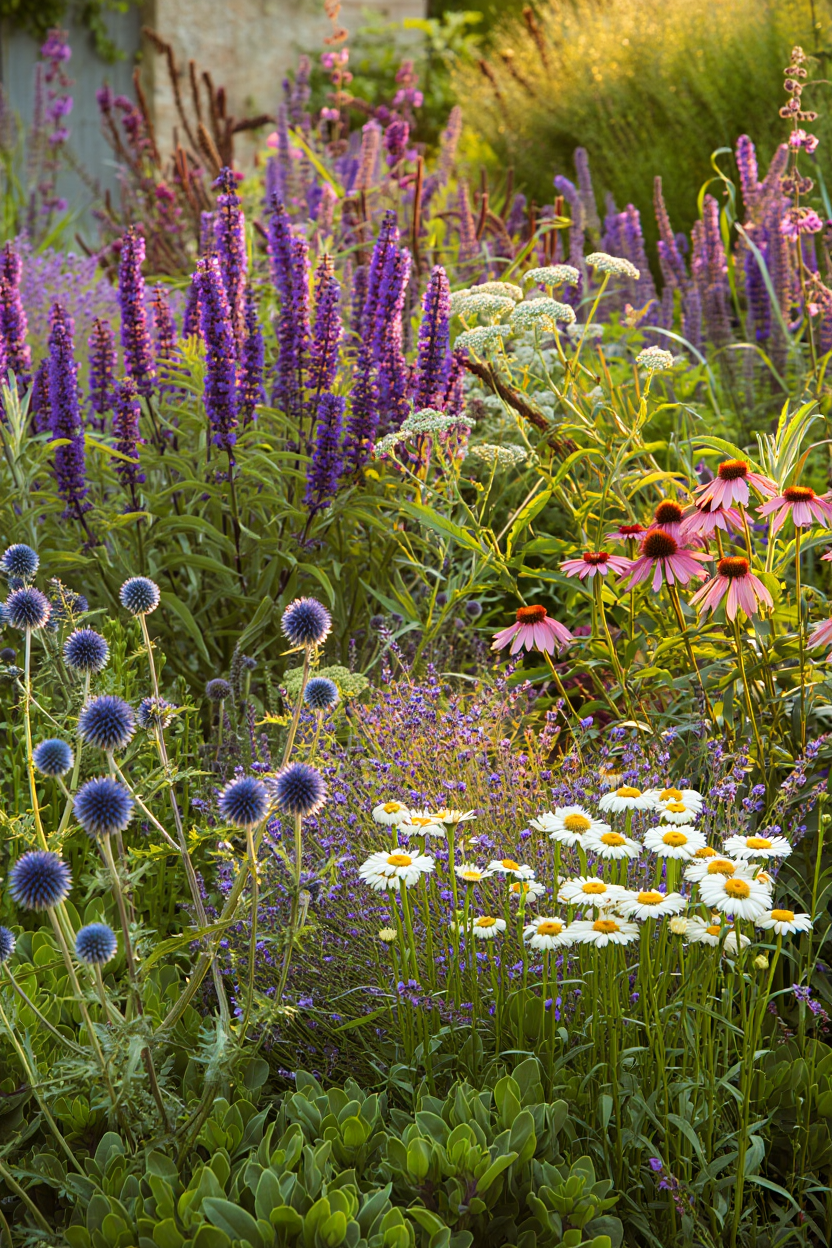
Let’s go through some basic rules, so you can pick the companion plant you need for your lavender shrubs from our list (or find others yourself).
A good companion plant for lavender should:
- Have the same growing conditions (full Sun, soil pH between 6.5 and 8.0, be drought tolerant).
- Be suitable in shape and size, or the composition in your garden will look “awkward”.
- Be good for the soil.
- Be a magnet for pollinators, though no one beats lavender itself.
- Be a pest repellent.
Now, there may be other specific qualities, and you will see them soon, because we are starting with the first “best friend” for your lavender shrubs right now!
1: Carnations and Pinks (Dianthus spp.)
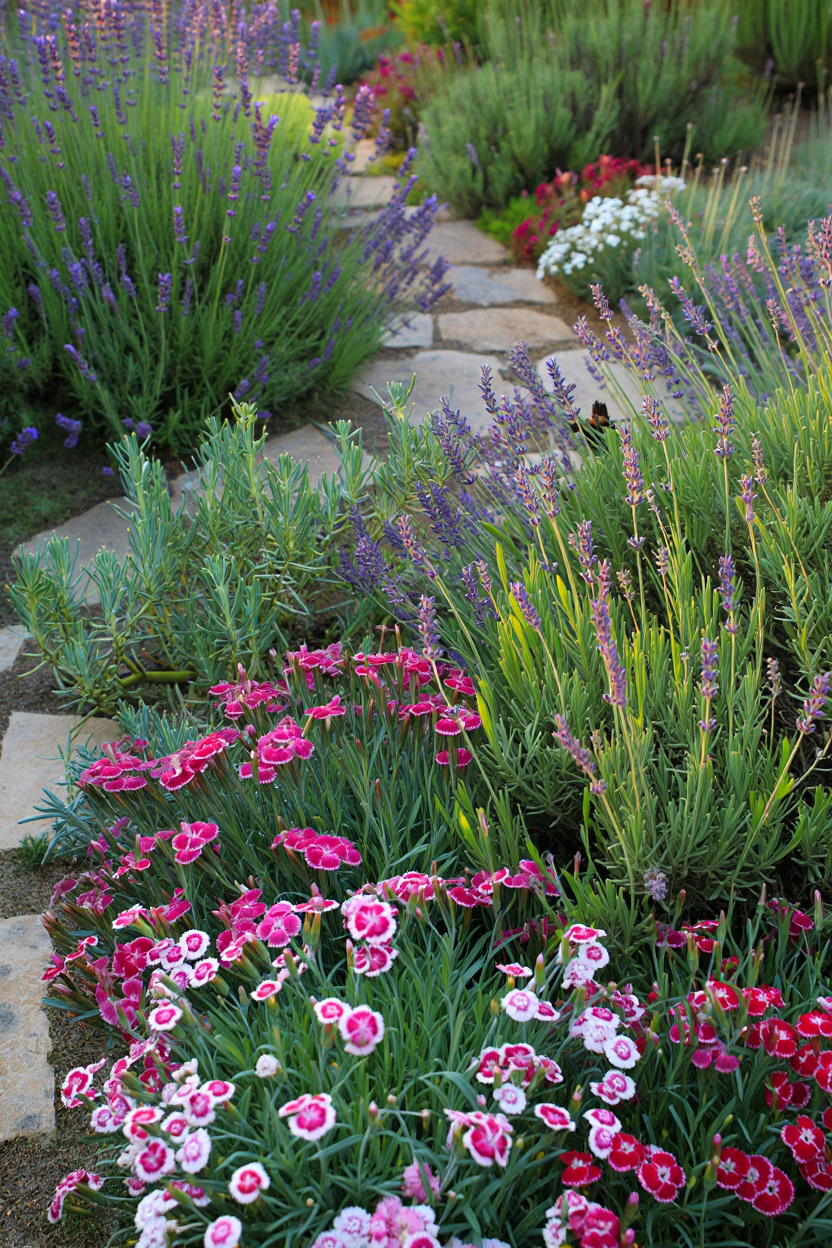
You know, I can’t make my mind up: which one has a better fragrance, lavender or carnations? It doesn’t matter, but it already tells you the first reason why they make excellent companions – your garden will smell like heaven!
And pollinators will notice it too, coming to your yard in huge numbers. On top of that, Dianthus will help lavender repel pests, rabbits and deer, and if you forget to water them once, don’t worry; they are both drought tolerant!
But which should you choose? For larger lavender varieties, like the English one (Lavandula angustifolia), I’d prefer bigger carnations, for Spanish or French lavender (Lavandula stoechas), I’d pick smaller but very fragrant pinks.
2: Sage (Salvia officinalis)
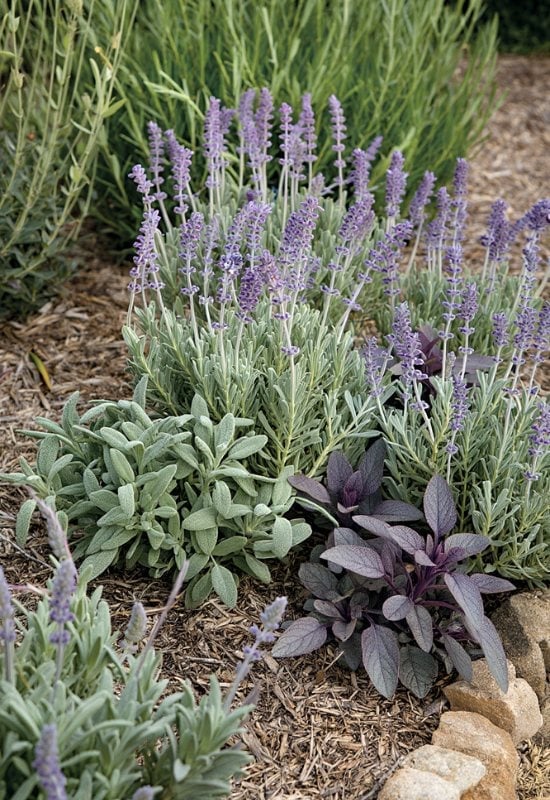
Sage and lavender share so many things in common: both are super fragrant, both repel pests, both can have bluish-silvery colored foliage, and both are drought tolerant! They are a match made in heaven, and they have different, but comparable sizes.
From an aesthetic point of view, leaves with a similar color but different shape and texture can be a nice touch, however, you can play with the different shades of the foliage of both lavender and sage – so you get a palette of green, silver, bluish and even purplish.
3: Rosemary (Rosmarinus officinalis)
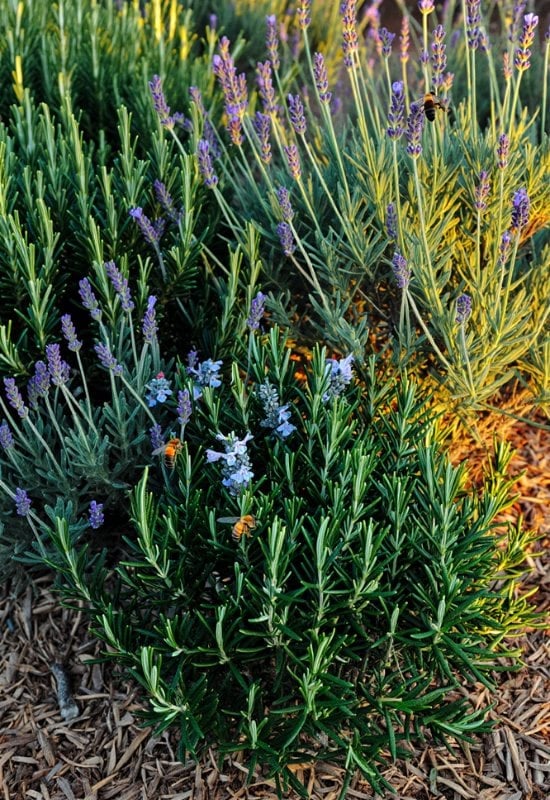
My main reason to pick rosemary as a companion for lavender would be that I would start attracting pollinators very early on in the season (it blooms profusely in late winter and early spring), then keep attracting them with Lavandula.
Having said this, they are both evergreen, drought tolerant shrubs with similar foliage in shape but very different in color, so the shiny, dark green needle like leaves of rosemary would contrast very nicely with the silver ones of rosemary.
And both keep mosquitoes away – a perfect partnership to protect your family!
4: Yarrow (Achillea millefolium)
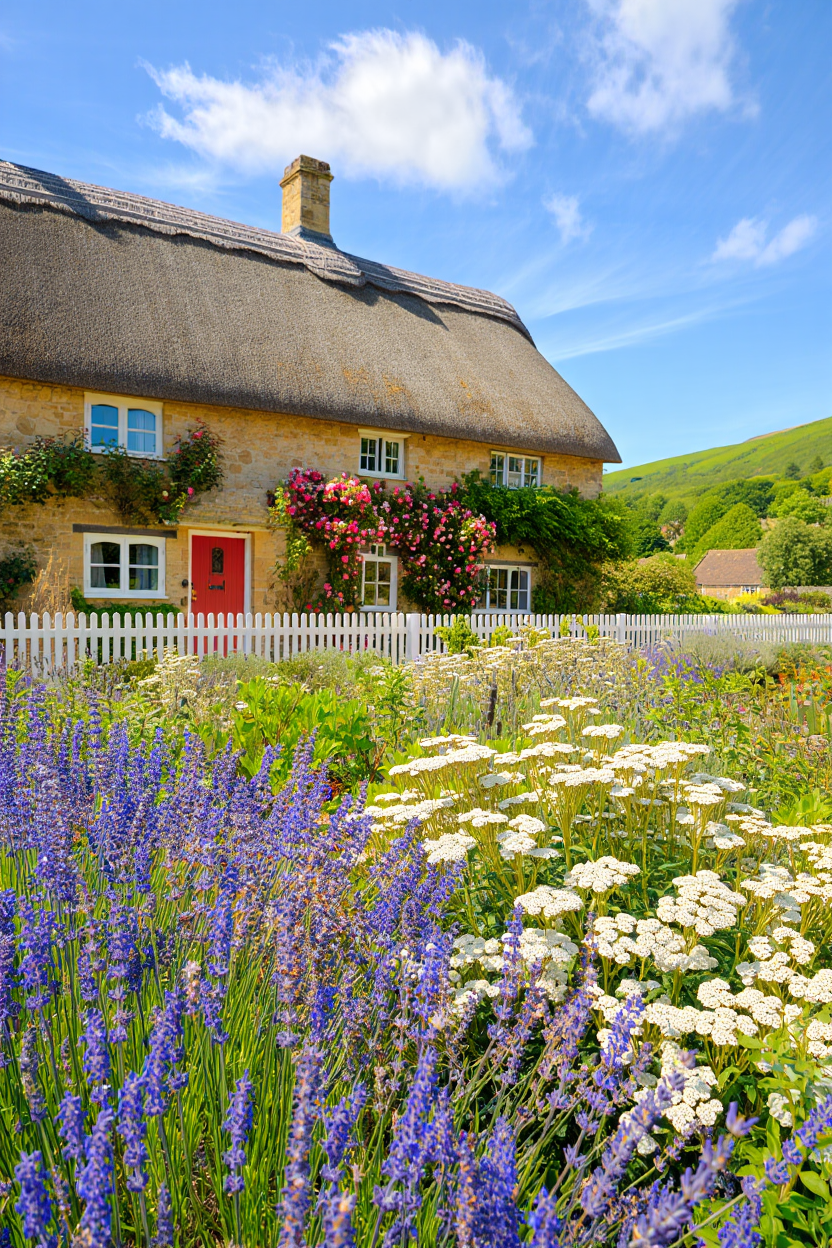
Both lavender and yarrow have medicinal qualities, but this is not the main reason to grow them together. Both are real magnets for pollinators, but Lavandula “specializes” in bees, bumblebees and butterflies, while Achillea is a favorite with small insects and beetles. You can certainly see why this is a powerful combination for your garden.
On top of this, yarrow also has long roots, which improve the soil and prevent erosion.
Yarrow and lavender, however, have a totally different color range and flower shape, so, that would offer a nice contrast to your garden, while the elegant and thin foliage would bring it together in texture.
5: Woodworm (Artemisia spp.)
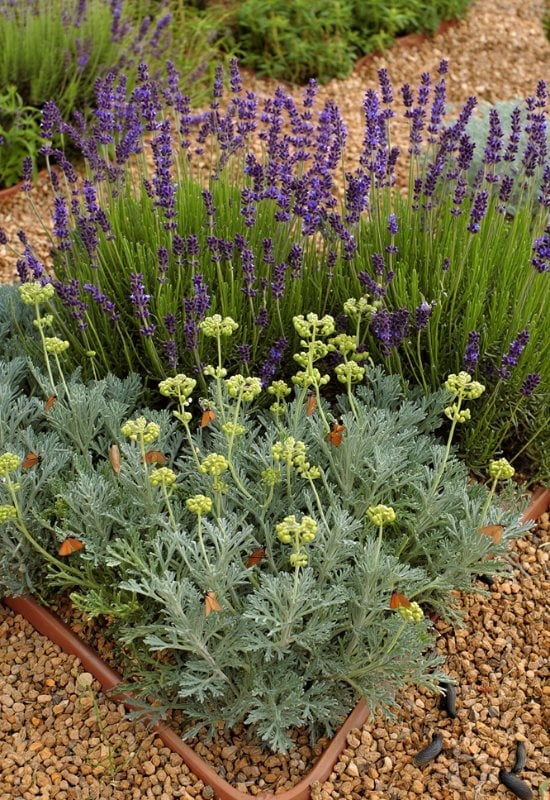
Can you picture the finely cut foliage of woodworm next to that of lavender? Considering Artemisia too has many varieties in silvery shades, like the famous Artemisia absinthium, I am sure you can see why these two plants make excellent companions, also considering their bushy nature.
Growing to 1 to 3 feet tall (30 to 90 cm), depending on the species, woodworm also adapts to different lavender varieties, and it has an extra bonus for your garden: it deters moths and slugs.
And then, there are the yellow flowers for some nice contrast to attract even more pollinators.
6: Santolina (Santolina chamaecyparissus)
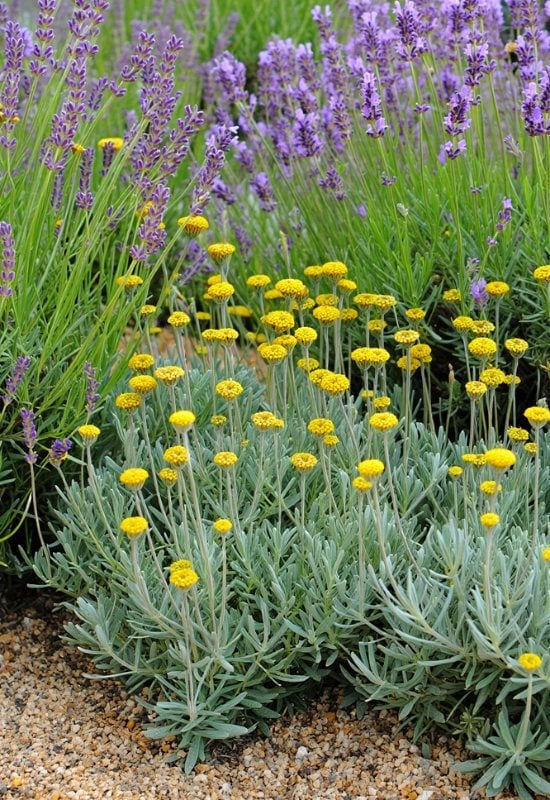
Shrubby santolina has lovely silvery and finely laced foliage, and it would be a great companion for smaller and bigger varieties of lavender, growing to 1 to 2 feet tall (30 to 60 cm). You may even confuse the two plants from a distance, but not when in bloom, because santolina has golden yellow flowers – loved by pollinators too.
On top of this, santolina will help lavender keep pests away, in particular moths and flees. Needless to say, it is drought tolerant.
7: Rockrose (Cistus spp.)
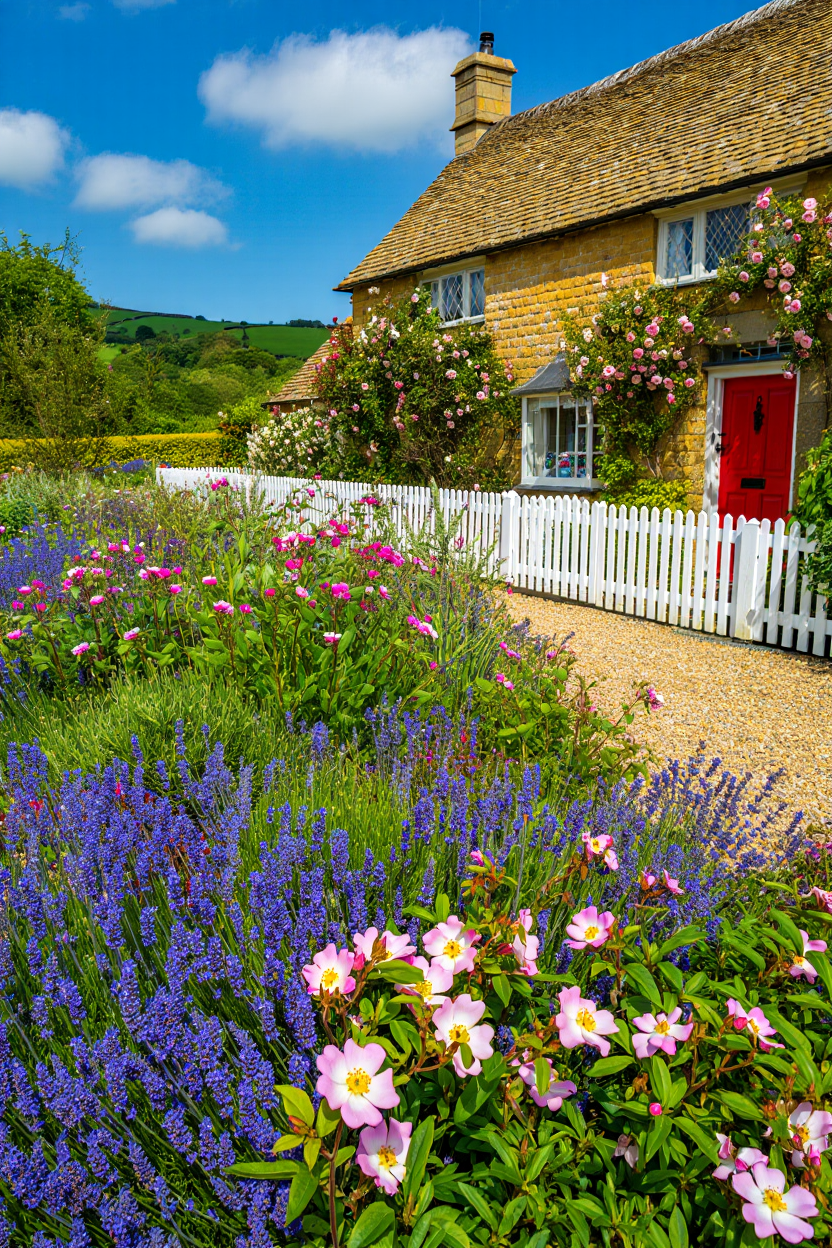
Both Lavandula and Cistus, or rockrose, come from the same region, the Mediterranean; so, they are natural companions. Why shouldn’t they be so in your garden?
Drought tolerant, these shrubs also match in size, and they both have small leaves, though rockrose flowers are big and round, as the name suggests, which do attract pollinators, but they also give you a contrast in shape with lavender’s.
Rockrose flowers range from magenta pink to white, thus they are harmonic with lavender blooms, and guess? This shrub is also excellent for poor and rocky soils, as well as a great fighter against soil erosion.
8: Germander (Teucrium chamaedrys)
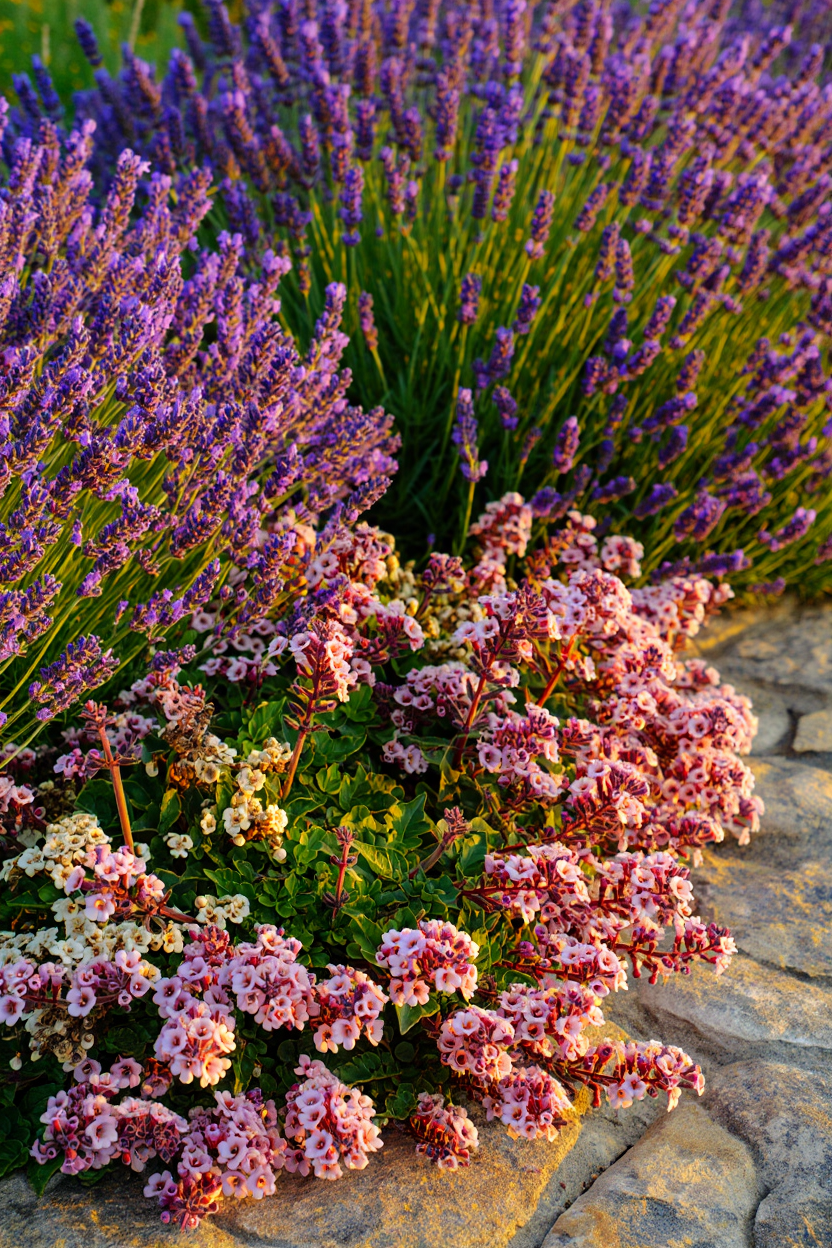
Here’s another shrubby friend from “back home” (the Mediterranean) for your lavender: germander. With rising stems that form a basket shape, packed with small dark green evergreen leaves, it will also blossom around the same time, with many small lavender pinkish to white florets that will attract even more pollinators to your garden.
And you guessed it: it is drought tolerant and it repels pests too.
9: Sweet Alyssum (Lobulariamaritima)
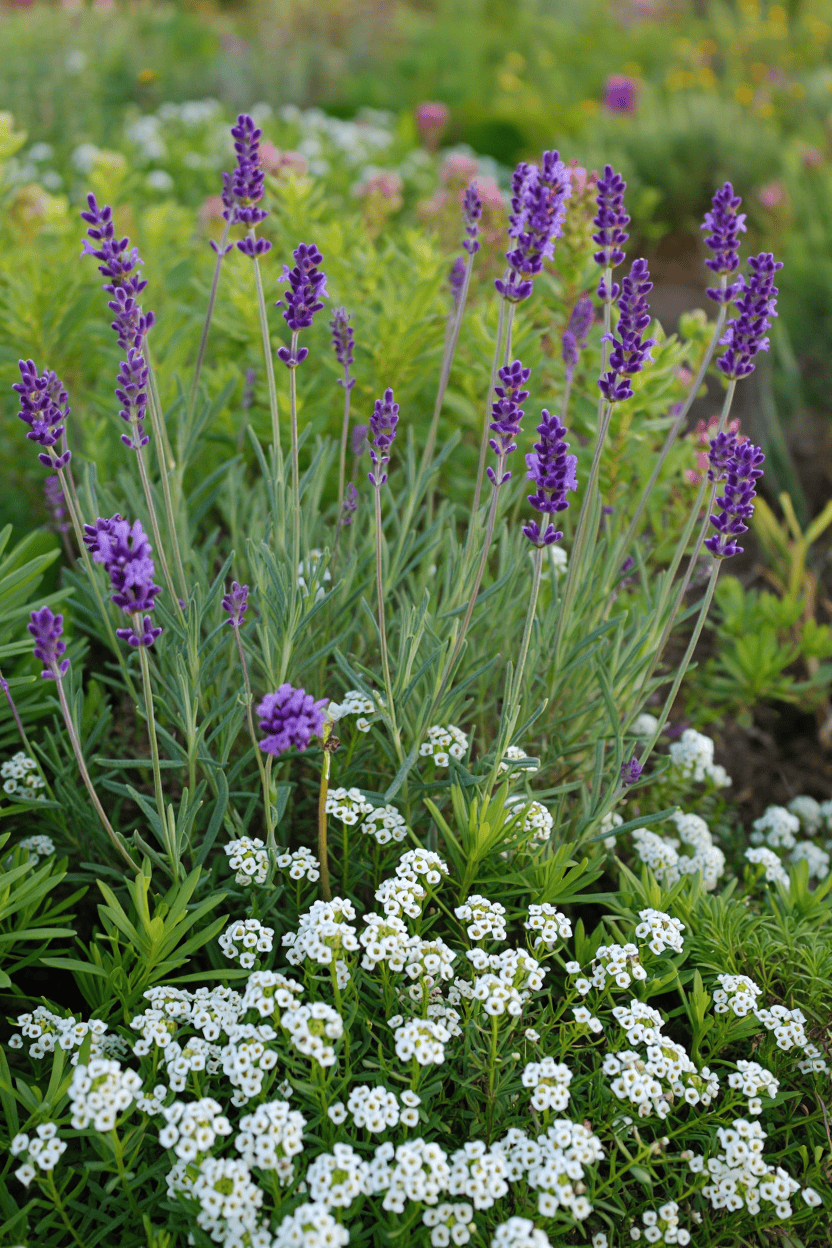
Grow sweet alyssum next to lavender and you will have blooms from late spring to fall, to complement the amazing, but shorter lived, ones of Lavandula. The colors match too, with whites and purples for both. And, of course, pollinators will enjoy this harmonic touch too.
Both Mediterranean in origin, both drought tolerant, loved by pollinators, however… For taller varieties of Lavender, I’d use sweet alyssum as a frame at their feet. For smaller ones, I would mix and match them “as equals”.
10: Sea Holly (Eryngium spp.)
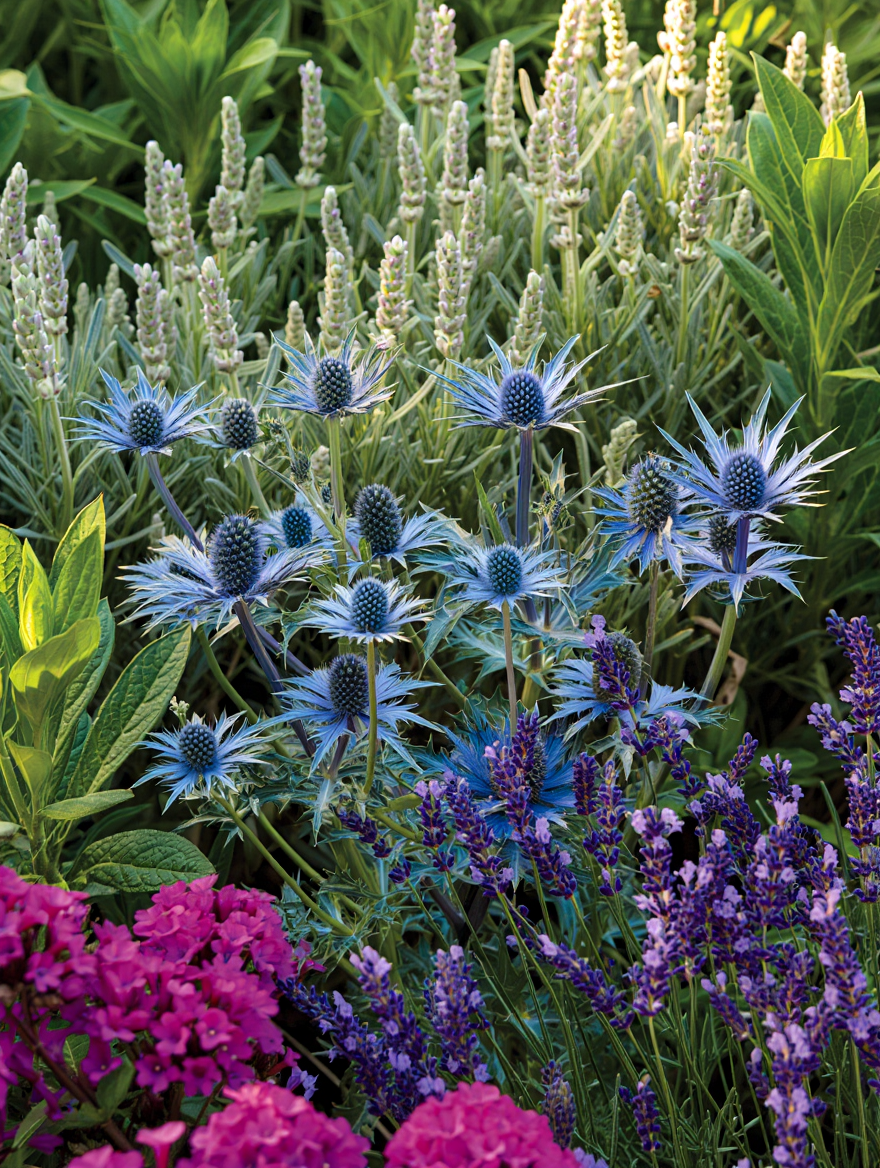
Sea holly is another “compatriot” of lavender, but with a massive personality. It’s amazing, long lasting thistle-like large blooms can be in super deep blue, or lighter tones, but also in violet and white. They will call pollinators to your garden from a distance, because they are not scared of the spiky look of this perennial and its foliage.
A great companion for lavender, with amazing sculptural value for your garden, it is also deer resistant and it grows in poor soil. The only drawback is that it may overshadow the gentle nature of our shrub.
11: Lamb’sEar (Stachysbyzantina)
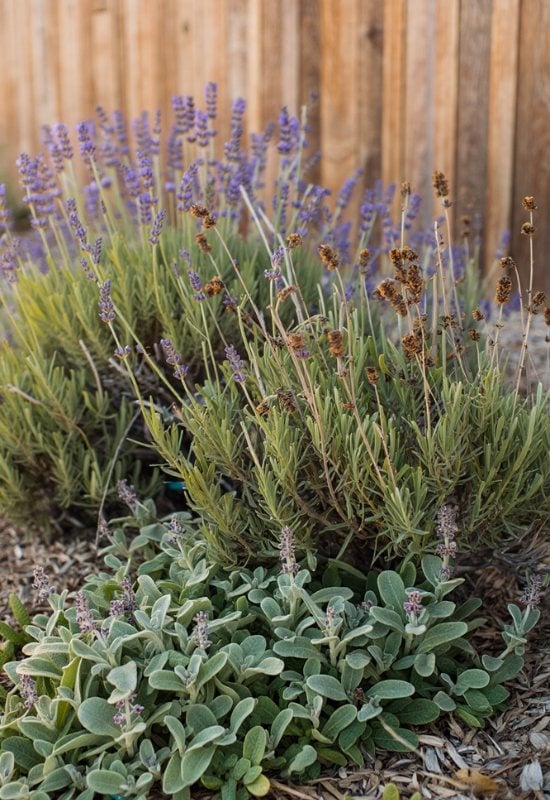
“You said that companion plants should match in size, and lamb’s ears are very small!” You are right, but we can use tiny plants for groundcover and if you need one for lavender, you can’t find a better one than Stachys byzantina.
Evergreen and drought tolerant, lamb’s ear has silver and fuzzy leaves, which cover the soil perfectly at the feet of lavender, retaining moisture and then they add those pretty flowers on slim stems for a long time, from late winter to summer (in waves).
And lamb’s ear also keeps creepy crawlies away from lavender shrubs.
12: Coneflower (Echinacea purpurea)
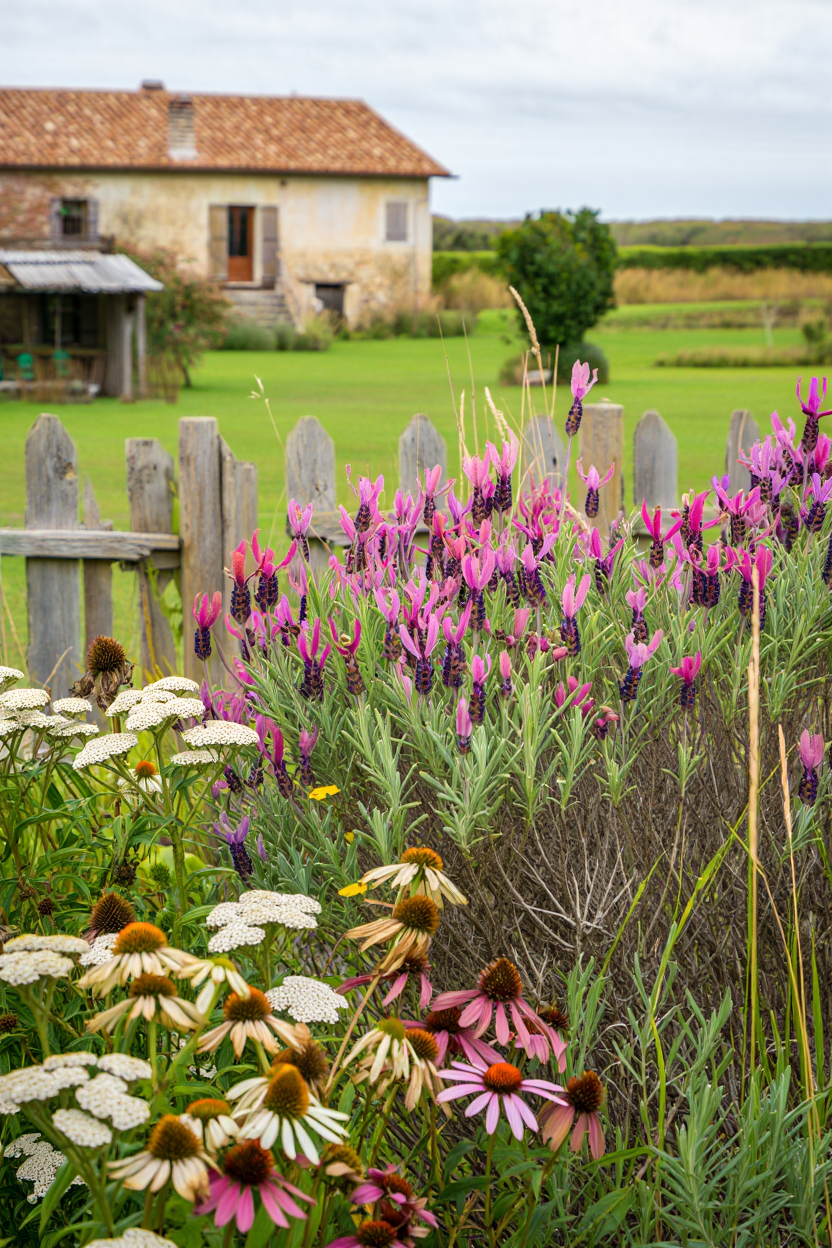
Now we go for contrast; coneflower has big, showy blossoms in warm colors, but it grows well with lavender because they like and tolerate the same soil conditions (like rocky, dry and poor soil), and together, they attract pollinators to your garden for a very long time indeed.
So, grow these gorgeous daisy-like flowers next to your lavender shrub, their large basal leaves will offer a rough but interesting contrast too, and maintenance is so low…
13: Oregano (Origanum vulgare)
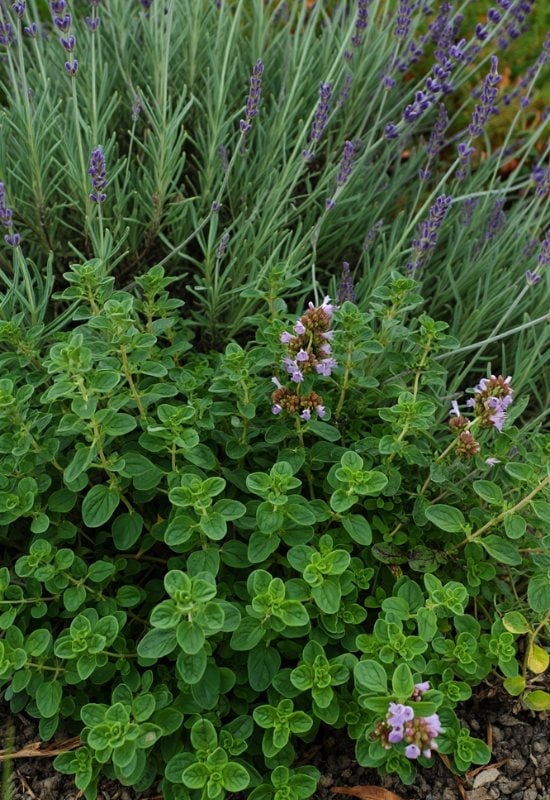
Most people think that oregano is tiny, but it actually grows to 3 feet tall (90 cm)! Its thin leaves don’t give away its height when in small jars… Its lovely lavender flowers will overlap the floral display of your lavender shrubs for a about two months, then keep on for a bit longer – you know what it means for pollinators.
On the other hand, oregano will help lavender keep pests away from your garden, while giving you an extra herb to harvest when the season is over. And yes, it is very decorative indeed!
14: Shasta Daisy (Leucanthemum x superbum)
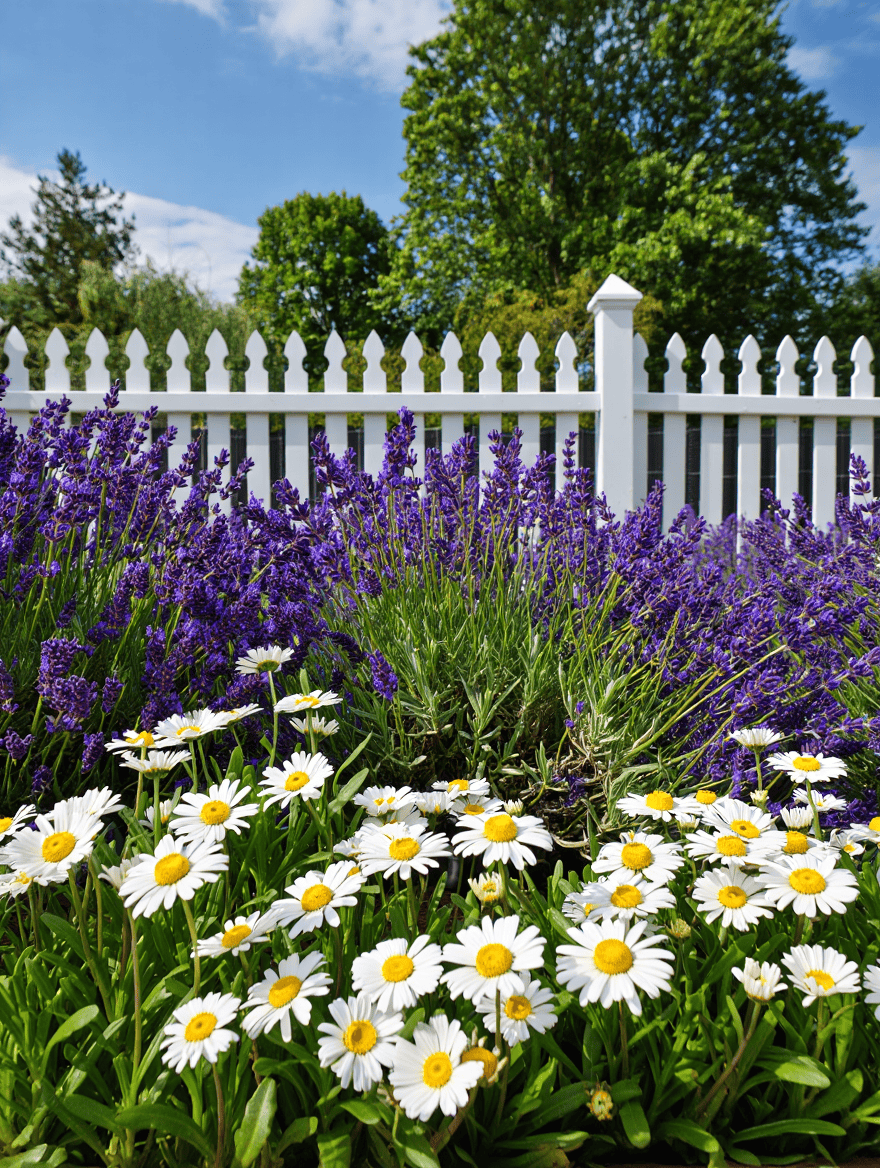
Think about big white daisies blooming alongside your lavender shrubs – great contrast isn’t it? “But daisies are not drought tolerant,” you may object. Shasta daisies are tough, and they also grow tall and proud, so they won’t be lost next to the most fragrant shrub in the world.
Shasta daisies will also offer contrast with their rich green and lush foliage, giving your garden a “fresh and lush” look, which is quite hard to achieve, especially if you are xeriscaping.
15: Hyssop (Hyssopus officinalis)
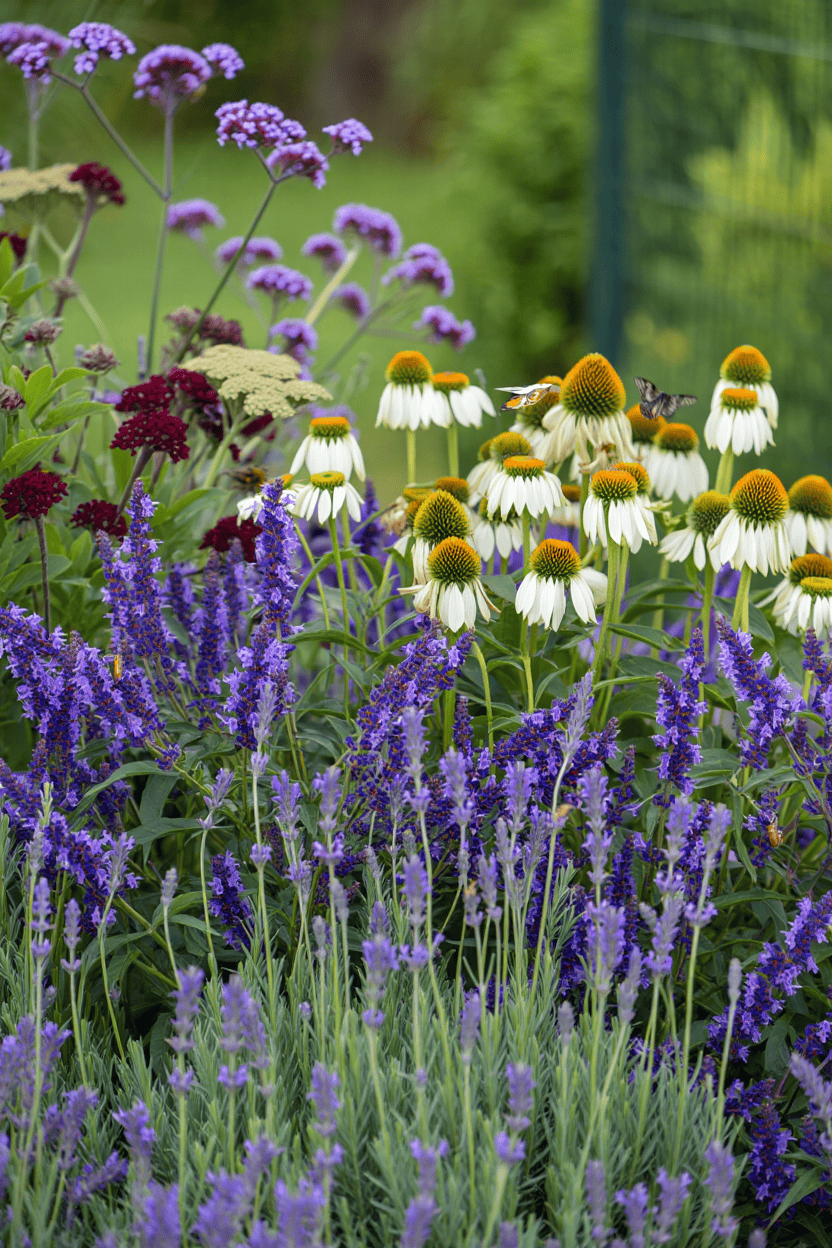
Look at the blossoms of hyssop: they look like the larger versions of lavender spikes! Often in deeper shades too. That’s why they look well together, and their blooming seasons overlap too.
While they also have comparable heights and size, hyssop and lavender really differ in one trait: their foliage is quite different… One offers you green lance shaped and pointed leaves, quite lush on the stems, the other silver or green, but needle like ones. But pollinators don’t seem to mind this difference – they love them both.
16: Cosmos (Cosmos spp.)
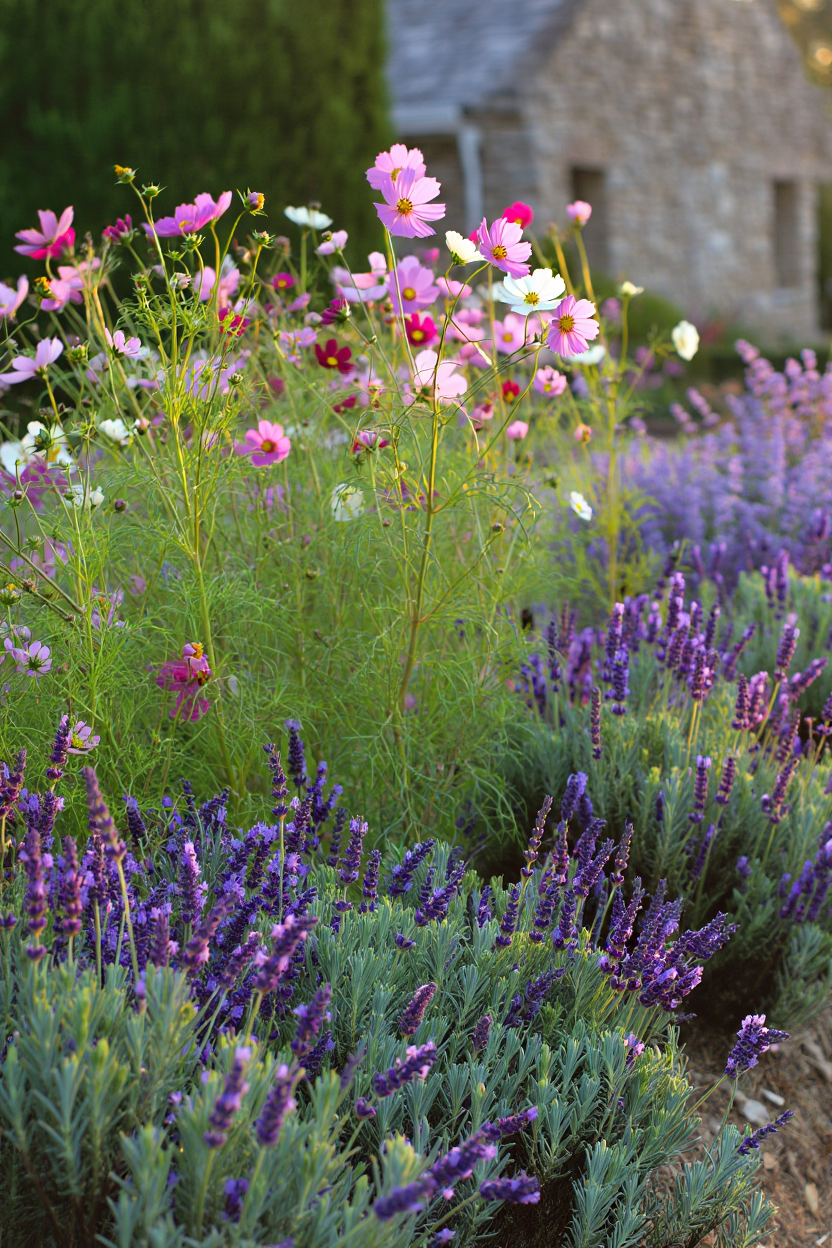
You wouldn’t think that frail looking cosmos, with its large, round, almost see-through blooms would be a good companion for elegant, fragrant, but very tough lavender, would you? Yet it is! And why? Put simply it is drought tolerant, and it tolerates many types of soil.
On the other hand, lavender and cosmos look totally different; one a herbaceous annual with finely laced leaves; the other an evergreen shrub. However, it is the very foliage that brings them together well, while in different colors.
So, if you want an easy to grow annual to match and contrast your lavender, you know which to choose.
17: Zinnia (Zinnia elegans)
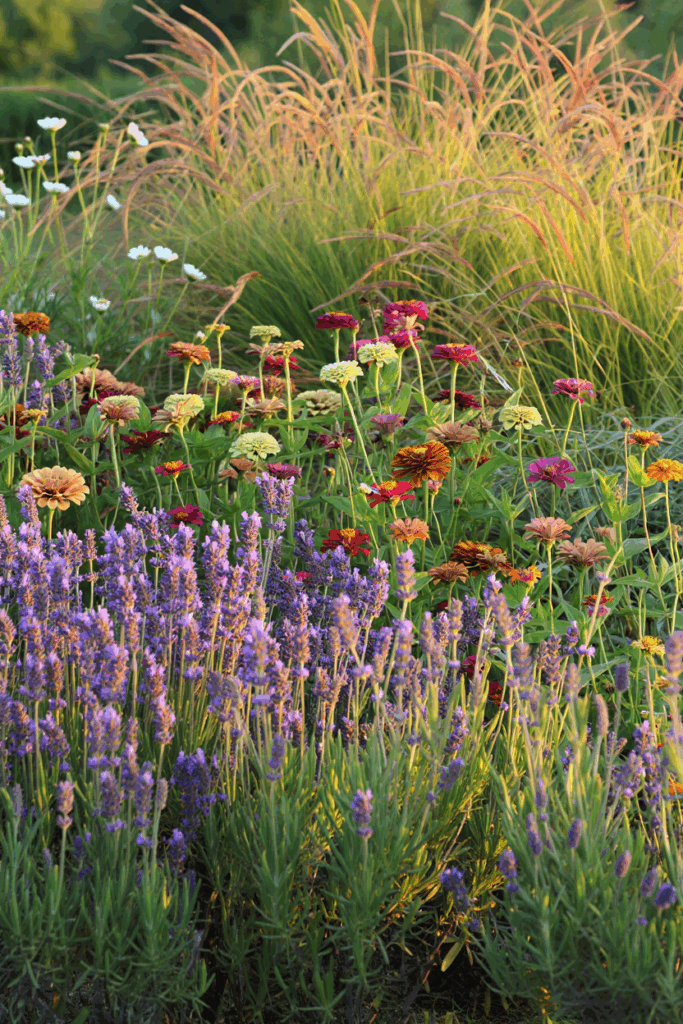
Like with the cosmos, zinnia flowers don’t look anything like lavender blooms. Nor do the leaves – green and lance shaped against silver and needle like. A lush and leafy annual “against” a tough-leaved flowering shrub. However, you guessed it: zinnia is drought tolerant as well, so you can grow them together.
Some of the flowers in the color range of zinnia will match with those of lavender, the purples and whites, others won’t (like yellow, orange, red). But this gives you more options. You can go for the full contrast, or for contrast with continuity. It is up to you – pollinators won’t mind whichever you choose!
18: Globe Thistle (Echinops spp.)
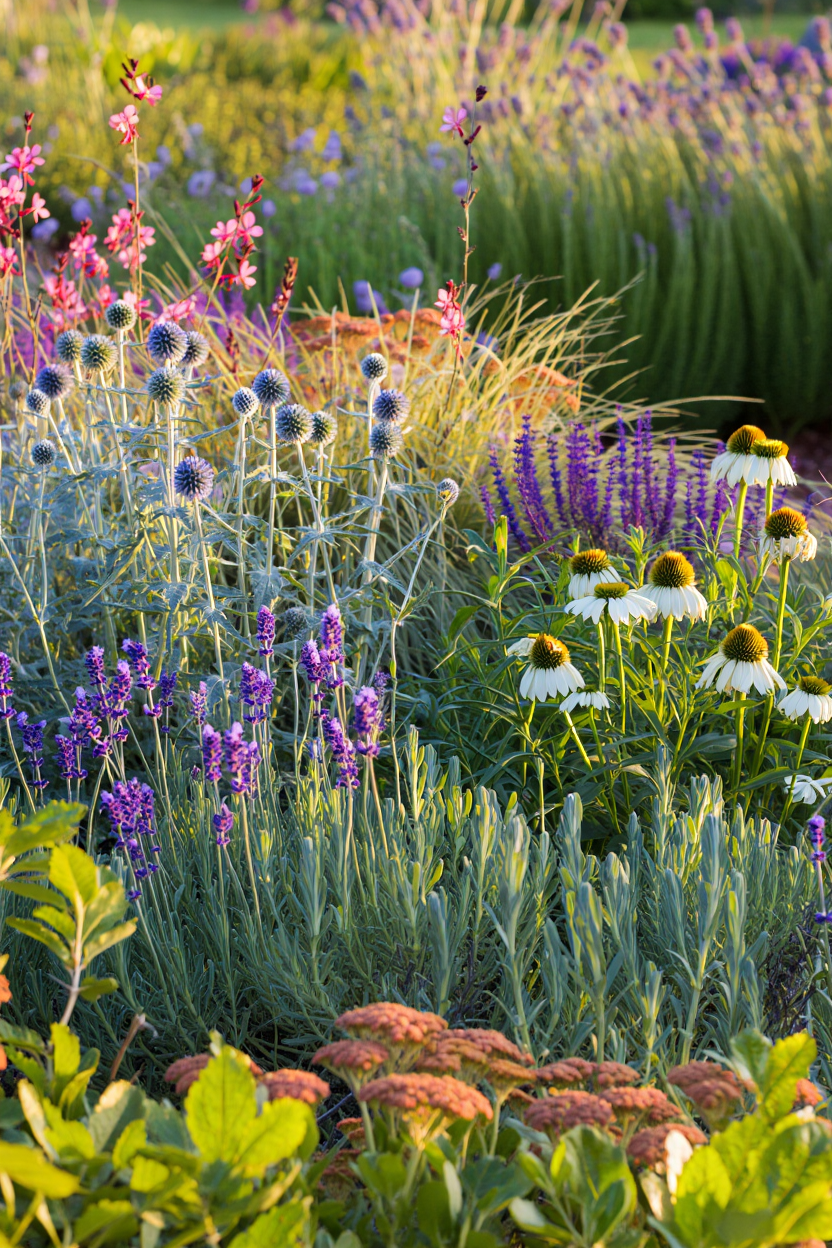
Now, imagine round “balls” in violet, lavender and bluish waving in the wind among your lavender shrubs… You may think you are witnessing a strange genetic mutation, but no… You are looking at globe thistles growing next to your fragrant Lavanula! The effect is really striking indeed, and because Echinopsgrows to about 3 feet (90 cm, depending on the species), their globular flowers (inflorescences) may appear just at the top of our protagonist’s branches.
Talking about different varieties, you can adapt this effect with taller lavenders (like Lavandula angustifolia) and shorter ones (L. stoechas). But look lower down the stems of your globe thistles and there’s the giveaway: the rich green deeply lobed and semi-glossy, spiky leaves make an interesting “change” from our fragrant shrubs.
And now, a real twist…
Which Plants Should You Never Grow as Companions to Lavender?
You now have an idea and a list of ideal plants to grow with lavender, but which should you avoid? In general, there are some that really don’t suit the same growing conditions as Lavanula’s, like:
- Water plants (obviously).
- Plants that require lots of watering.
- Plants that require shade.
- Big and shady trees.
- Very tender plants.
But now, let’s look at a few no-no varieties.
1: Camellia (Camellia spp.)
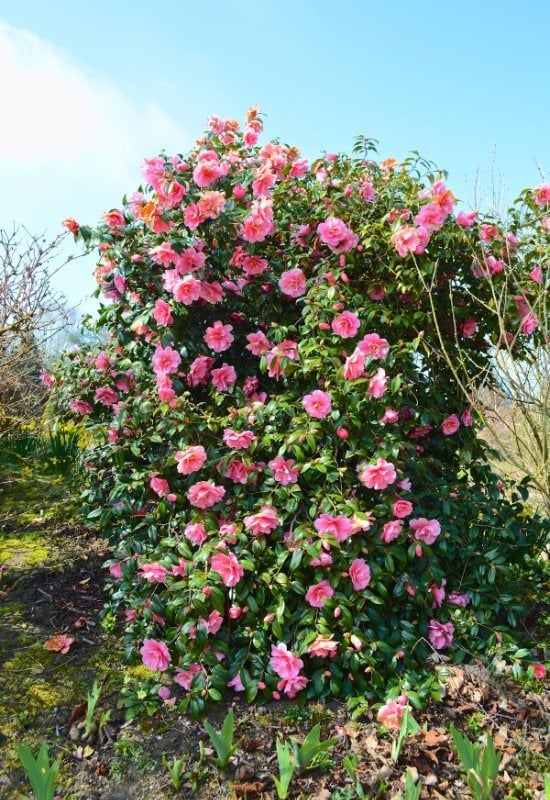
Beautiful though camellias are, you cannot grow them with lavender. You may think that there’s an aesthetic mismatch between these two shrubs, and I would agree with you, but this is not the main reason – if you want a crazy garden, fine by me…
The problem is that camellias don’t like full Sun and extreme heat, unlike lavender, and they need very regular watering. But there is an even bigger, more problematic reason, camellias need acidic soil pH, between 5.5 and 6.5, so out of lavender’s range.
2: PlantainLilies (Hosta spp.)
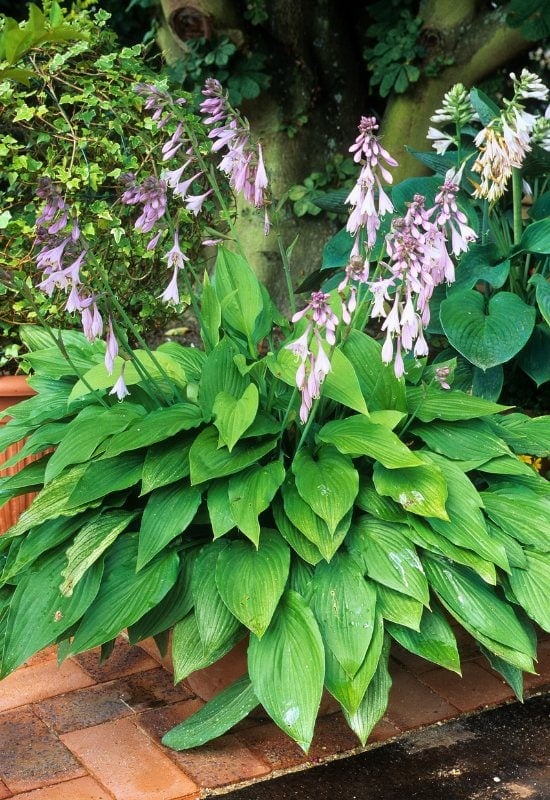
You may think that growing plantain lilies at the feet of your lavender may protect them from pests – and we all know Hosta is very susceptible to them. And maybe you would, but still these two plants won’t thrive together. Why?
Plantain lilies need a lot of water and shade. “But I want to grow it under my lavender,” you may say. Our fragrant shrubs simply don’t produce enough shade for Hosta, and they don’t like “wet feet” anyway.
3: Cabbage and Other Brassicas (Brassicaceae)
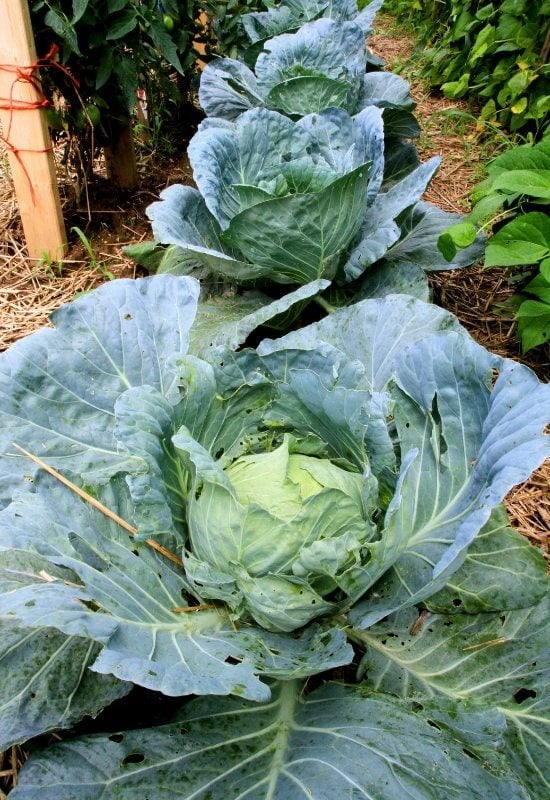
Ok, lavender is great in a herb garden or back yard, maybe to shade and “deodorize” your compost bin. True, but never grow any brassicas near this fragrant shrub.
The reason is that brassicas are really heavy feeders, and they know how to get their food. They may lead to the decay, or at least weakening of your lavender shrubs.
4: Azaleas and Rhododendrons (Rhododendron spp.)
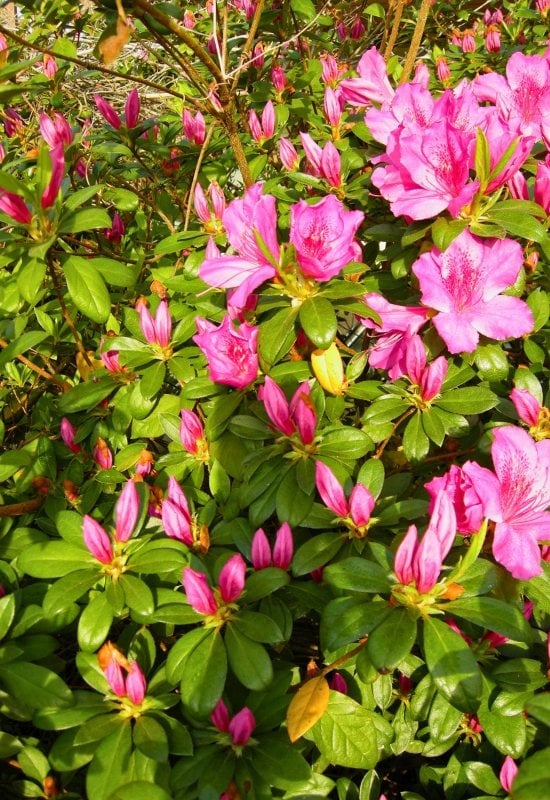
Here is another bad match, for the eye (or the style, or harmony of your garden), but for more important reasons too: azaleas and rhododendrons don’t grow well with lavender.
The reason is the same as with camellias, but at a higher level… Azaleas and rhododendrons need a pH between 4.5 and 5.5! Ok, they will survive with acidity of 6.0, but that’s still too low for lavender.
5: Basil (Ocimum basilicum)
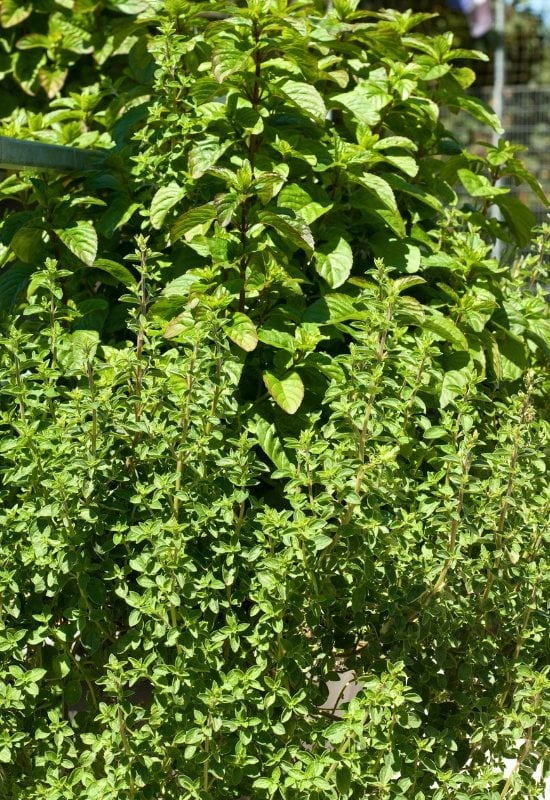
Here is another disappointment for your backyard… Sigh, both basil and lavender are herbs for your kitchen, but sadly, the fresh and leafy annual we use in salads and on pizzas needs rich soil and loads of water, while the fragrant shrub prefers lean and dryish soil.
If you want though, you could still grow basil in containers next to lavender, maybe if you are short of space in your kitchen garden?
Good Friends and “Bad Friends” for Your Lavender Shrubs
We’ve come to the end. Of course, as I said, there are more “good friends” and “bad friends”, but now you know which are the very best companions for lavender – even “family” at times (coming from the Mediterranean, I mean) and some mismatches too. But, above all, you now have guidelines, the principles of what makes a good and a bad companion plant for lavender, so you can be a “responsible parent”…

Written By
Amber Noyes
Amber Noyes was born and raised in a suburban California town, San Mateo. She holds a master’s degree in horticulture from the University of California as well as a BS in Biology from the University of San Francisco. With experience working on an organic farm, water conservation research, farmers’ markets, and plant nursery, she understands what makes plants thrive and how we can better understand the connection between microclimate and plant health. When she’s not on the land, Amber loves informing people of new ideas/things related to gardening, especially organic gardening, houseplants, and growing plants in a small space.
